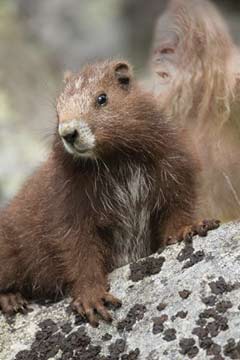How they got there is a story of rescue, recovery and release. Don Doyle let out an audible sigh of relief as he flew over Greig’s Ridge in Strathcona Park, Vancouver Island. He’d spotted the muddy stains on the snow that are sure signs of unplugged marmot burrows, along with multiple marmot tracks within the meadow.
“The marmots are up and all over the place” he reported happily, “there’s lots of open habitat and the ridge looks great. Better than last year.“
Don Doyle is the Chair of the Vancouver Island Marmot Recovery Team and he had just made the first fly over to check on the reintroduced marmots since they went into hibernation last winter. They had awoken safely and were doing what marmots do, exploring their terrain and rekindling their relationships.
The volume of late season snowfall had Don worried the marmots might wake up before the bowl had warmed enough to slough off the snow and begin to green up, leaving them without food and warm rocks to sun on, but everything looked fine.
Last summer nine Vancouver Island marmots born in a zoo based captive breeding program run by the Marmot Recovery Foundation were released to this site in Strathcona Park. Two more groups will be added this summer with third group going to a historically occupied site on the other side of Buttle Lake, on Mt Adrian.
All are part of a larger recovery strategy that will see up to 60 animals reintroduced to different parts of Vancouver Island this summer with a final goal of establishing 400-600 animals in 3 sustainable population groups on the island.
“Currently, there are approximately 84-94 Vancouver Island marmots in the wild. That may not sound like many but it’s a big improvement over the less than 30 animals that remained in the wild in 2003” said Don.
The turn around is the result of a captive breeding program begun in 1997 as an emergency measure to protect and maintain the species. Because of the lack of breeding aged animals, it was slow to start, with the first 4 pups born in 2002, but it is now expected to produce an incredible 50-60 pups a year to augment the wild population and re-colonize other historical marmot sites. All very good news for Canada’s most endangered mammal.
“We’re facing a critical time in the recovery process,” said Don. “The wild population is in crisis with only 3 litters of pups born in the wild last year. We know that reintroduced animals are reproducing and surviving in the wild almost as well as wild born animals and we can now release up to 60 animals a year. It only makes sense that this will improve the odds of litters being born in the wild and improve the long-term chances of Vancouver Island marmot survival, providing we have the resources to get them out there”.
Vancouver Island marmot terrain is remote and difficult to access. Helicopters must be used to fly the marmots into their new homes and researchers must closely monitor the marmots to determine the causes of mortality, survival rates, reproduction, dispersal and ultimately the success or failure of the program.
For more information or if you would like to assist with the recovery of Canada’s most endangered mammal, please visit www.marmots.org
